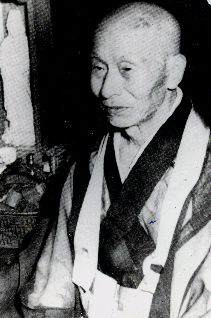Harada Daiun Sogaku
Harada Daiun Sogaku | |
|---|---|
 | |
| Title | Rōshi |
| Personal | |
| Born | October 13, 1871 |
| Died | December 12, 1961 (aged 90) |
| Religion | Zen Buddhism |
| School | Sōtō |
| Education | Komazawa University |
| Senior posting | |
| Successor | Hakuun Yasutani Harada Tangen |
Daiun Sogaku Harada Rōshi (October 13, 1871 - December 12, 1961) was a Sōtō Zen monk who trained under both Soto and Rinzai teachers and became known for his teaching combining methods from both schools.
Biography
Born in an area known today as Obama, Fukui Prefecture, he entered a Sōtō temple as a novice at age 7 and continued training in temples during his primary and high school years. At age 20 he entered Shogen-ji, a well-known Rinzai monastery; it is reported that he experienced kensho after two and one-half years there. In 1901 he graduated from Komazawa University (then Sōtō-shu Daigakurin), the Sōtō university. He eventually studied under various Sōtō and Rinzai masters such as Harada Sodo Kakusho,[1] Oka Sotan, Akino Kodo, Adachi Tatsujun, Hoshimi Tenkai, Unmuken Taigi Sogon, and Kogenshitsu Dokutan Sosan. From the years of 1911 to 1923, Harada held a professor position at Soto-shu Daigakurin. A very strict disciplinarian, he served as abbot at various Sōtō temples throughout Japan: Hosshin-ji, Chisai-in , Ankoku-ji, Bukkoku-ji, Soji-ji and Chigenji. Until almost age 90, he conducted week-long sesshin at Hosshin-ji 6 times a year; he also held sesshin elsewhere.
Harada Roshi's teaching uniquely integrated Rinzai methods, namely the use of Kōan. He also departed from the Sōtō conventions of his day by training lay persons with monks rather than separately. His best-known heir was Hakuun Yasutani Rōshi, a Sōtō monk who he also trained in koan study. This led ultimately to the spread of combined Sōtō and Rinzai methods by the Sanbo Kyodan, a new Zen sect founded by Yasutani which became very influential in the West. Harada himself, however, remained within the Sōtō sect. It is often claimed in the West that he received Rinzai dharma transmission (inka shomei) from Dokutan Rōshi. Harada Rōshi may be viewed as an eclectically talented Sōtō teacher who did not abide by sectarian boundaries in regard to practice method. Others heirs from Harada Roshi are: Harada Tangen Rōshi Head of Bukkoku-ji temple; Bantetsugu Tetsugyu Ban; Watanabe Genshu, Head of Soji-ji temple among others. [2]
See also
References
- ^ Dharma Heirs and Teachers of the Harada-Yasutani school (Edited by Dr T. Matthew Ciolek) at http://www.ciolek.com/WWWVLPages/ZenPages/HaradaYasutani.html
- ^ Harda School at http://www.ciolek.com/WWWVLPages/ZenPages/HaradaYasutani.html
External links
- Sanbo Kyodan teachers and heirs Sanbo Kyodan: Harada-Yasutani School of Zen at the WWW Virtual library (Edited by Dr T. Matthew Ciolek)
